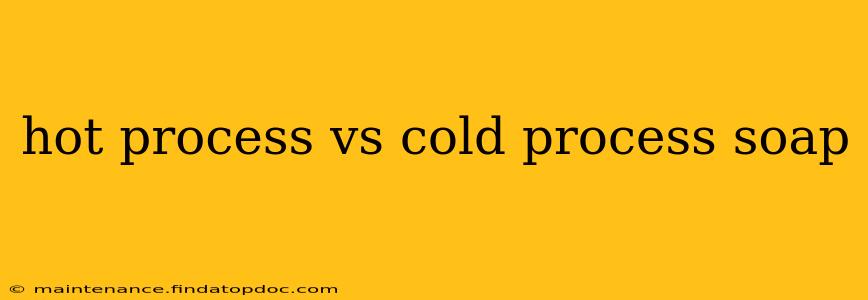Choosing between hot process and cold process soap making can feel overwhelming for beginners. Both methods produce soap, but they differ significantly in their process, resulting in soaps with unique characteristics. This guide will explore the key differences, advantages, and disadvantages of each method, helping you decide which is right for you.
What is Cold Process Soap Making?
Cold process soap making involves a saponification process where fats and oils are mixed with lye (sodium hydroxide) at room temperature. The chemical reaction, saponification, generates heat, but the mixture isn't actively heated. The resulting soap mixture, or batter, is poured into a mold and allowed to cure for several weeks.
Advantages of Cold Process Soap Making:
- More gentle on the skin: Because the saponification process isn't rushed, the potential for harsh chemicals to remain in the soap is minimized.
- Greater design flexibility: Cold process soap allows for intricate designs, color variations, and the inclusion of additives like herbs and essential oils.
- Longer shelf life: Properly cured cold process soap can last for years.
Disadvantages of Cold Process Soap Making:
- Longer curing time: Cold process soap requires a 4-6 week curing period before it's suitable for use.
- More time-consuming: The process is more hands-on and requires more waiting time.
- Requires precise measurements: Incorrect measurements can result in a soap that is too harsh or doesn't fully saponify.
What is Hot Process Soap Making?
Hot process soap making accelerates the saponification process by heating the soap batter. This is typically done using a double boiler or crockpot, ensuring the batter reaches a specific temperature. The soap is cooked until it reaches a specific consistency, usually a pudding-like state, signaling saponification is complete.
Advantages of Hot Process Soap Making:
- Faster curing time: Hot process soap generally requires only a few days to cure, sometimes even immediately usable.
- Quicker process: The entire process is significantly faster than cold process.
- Less chance of unsaponified oils: The heat ensures complete saponification, reducing the risk of leftover lye or oils.
Disadvantages of Hot Process Soap Making:
- Harshness: Some find hot process soap can be slightly harsher on the skin than cold process due to the high temperatures used.
- Less design flexibility: The intense heat can affect the appearance and texture, making intricate designs more difficult.
- Stronger scent: The heat can cause a stronger scent compared to cold process.
What is the difference in the final product?
The main difference in the final product lies in texture and feel. Cold process soap often has a more luxurious, creamy lather and a longer-lasting bar. Hot process soap tends to have a firmer, denser bar with a potentially less creamy lather. However, these are generalizations, and the final result depends on the specific recipe and ingredients used in both processes.
How long does each soap take to make?
The time commitment differs drastically. Cold process soap making takes significantly longer due to the 4-6 week curing time. Hot process is considerably faster, often completed within a day or two.
Which process is better for beginners?
Both methods have their learning curves. For beginners, hot process is often recommended due to its faster processing time and less stringent requirements for precision. The immediate results are also encouraging for new soap makers. However, experienced soapmakers often appreciate the creative control and skin-friendliness of cold process.
Is one soap better for sensitive skin?
Generally, cold process soap is considered gentler for sensitive skin. The slower saponification process allows more complete neutralization of the lye, reducing the chances of irritation. However, this is not a guaranteed rule; individual reactions vary.
Which soap making method is more environmentally friendly?
Both methods can be environmentally friendly with careful ingredient choices. Using sustainable oils, avoiding palm oil, and employing eco-friendly packaging are important factors regardless of the process used.
Which method is easier to clean up?
Cleanup for both methods is similar, requiring thorough rinsing of equipment. However, some find the hot process soap batter easier to clean because it's less sticky than the cold process batter.
By understanding the key differences between hot process and cold process soap making, you can choose the method that best suits your skills, time constraints, and desired outcome. Happy soap making!
